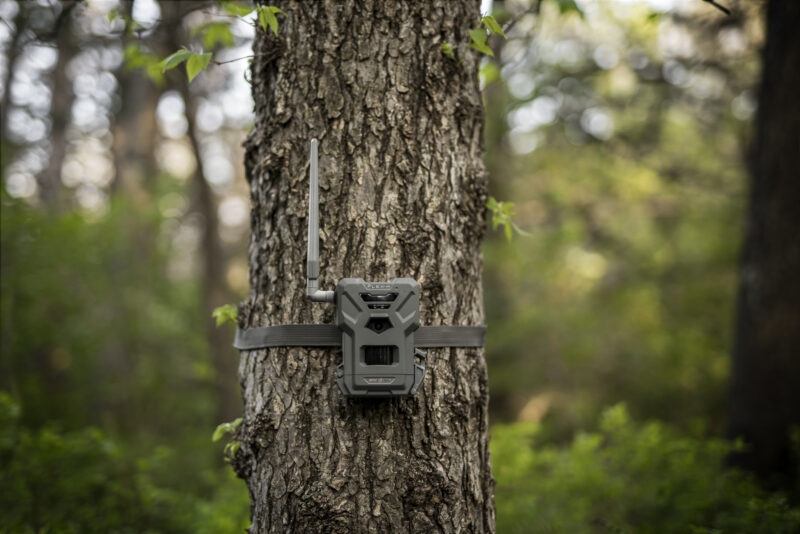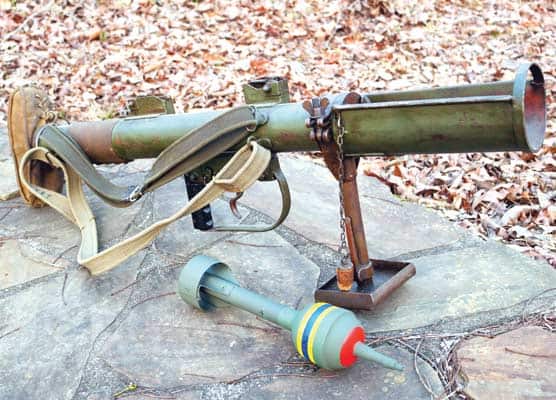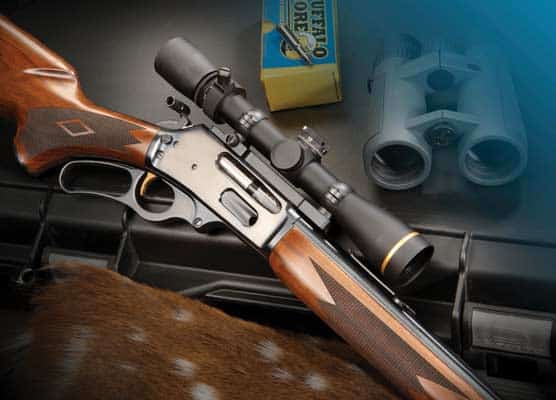A-Grade "A1's"
Inland’s M1A1 .30 “Paratrooper” Carbine And 1911A1 .45 Are
Made-In-The-USA Facsimiles Of The Originals
With all the hoopla about black rifles and polymer-framed handguns nowadays, I often feel like a dinosaur. Then a new company comes along and brings back good old wood-and-steel firearms. When it happens, it’s like a draft of cool air from an air conditioner on a 101-degree day! Add in the fact these “new” guns are detailed after legendary historic ones, pure bliss.
The outfit I’m talking about is Inland Manufacturing of Dayton, Ohio. The guns I’m talking about are primarily their new .30 M1 Carbines and .45 Government Models, each being offered in several versions. And get this—they are “Made in USA.”
The ones I have on hand are reproductions of the original “A1’s.” That is the M1A1 .30 Carbine “Paratrooper” and the 1911A1 .45 pistol. And I do mean reproductions, because they are just like the originals. Show someone the new Inland 1911A1 side-by-side an original, in good condition, and the only way they will be able to tell the difference is by reading the markings on each gun. I know. I’ve fooled several friends this way.
Pulling the wool over someone’s eyes with the M1A1 is a bit more difficult, because its walnut stock’s condition is obviously new, while all original “Paratroopers” were made over 70 years ago. They can’t help but have gathered at least some nicks and dings along the way.
First a few words to reiterate the history of .30 Carbine. Interestingly, the story actually starts with the cartridge. In 1940, the US Army foresaw a need for a “light rifle” with which to replace .45 pistols because they deemed the latter too difficult to train novices to the level of proficiency. It was the same problem with the .45 ACP Thompson SMG.
So Winchester Repeating Arms was approached to develop a new .30 caliber cartridge based on their old .32 WSL (Winchester Self-Loading). The government wanted a 100- to 120-grain 0.308-inch bullet at 2,000 fps. Eventually, both parties settled on a cartridge featuring a 110-grain bullet at 1,970 fps.
That first lot of 50,000 cartridges was passed out to several manufacturers and even private individuals for developing a “light rifle.” The first inspection of designs was in May 1941. None of the submissions were even acceptable to the point of going to live-fire trials. Another round of tests was scheduled for September of that year. Winchester had not submitted a “light rifle” prototype but was unofficially urged to bring one to the second test. Of course the company won the contract, and, along the way, the name “M1 .30 Carbine” was bestowed on the new gun. It was an all wood-and-steel 5-pound semi-auto firearm with a 15-round magazine (30 round ones were developed in the coming years).
Production of the new carbine was a feat likely to never be duplicated in this country. From December 1941 until war’s end, about 6-1/4 million M1 .30 Carbines were produced by 10 different manufacturers.
So what is an M1A1 .30 Carbine? It is simply the M1 barreled action dropped into a folding stock to help compact it for use by airborne troops. The buttstock hinges near the rear tang and folds to the left side. It is called a “wire” or “skeleton” style stock. A pistol grip was added. Standard M1 Carbines are 36 inches overall with 18-inch barrels. So are M1A1’s, but with stocks folded the length is reduced to 26 inches. Only Inland Manufacturing produced the A1 version––to the tune of slightly over 140,000 units.
That small percentage of M1 .30 Carbine production becoming M1A1’s is the reason originals are so pricey today. I’ve built a large collection of World War II firearms ranging from a French Model 1935A 7.65 pistol to a M1 Thompson .45 SMG. So far, for an M1A1, I have settled for a Saginaw Steering Gear manufactured barreled action set in a new replica stock. I simply couldn’t find an original in my price range.
Just about every reader of firearm periodicals knows that John M. Browning developed the Model 1911 for Colt, and the US Army adopted it in April 1911. Thereafter, it served as the Army and Marine Corp’s standard sidearm until 1985. What some readers may not know is the original intent for the 1911 was as a sidearm for horse-mounted troops. Hence the three-safety design: a lever on left side of the frame, a grip safety and a 1/2-cock notch. The idea was if the cavalryman had his pistol unholstered and fell off his horse the gun would not go off.
In the 1920’s, after the 1911 had been used in much combat, there were some minor alterations done to the design. The most visible were the arched mainspring housing at the grip’s rear and bevels to the frame just behind the trigger. These design modifications are what resulted in “A1” being added to the model designation. Shortly prior to WWII, the military decided all its firearms would have the matte finish called Parkerizing. This is why some original A1’s are blued and most others “Parked.” All military A1’s had the same 5-inch barrel and 7-round magazine, just like the original 1911. Slightly into the war, plastic grips replaced wooden ones. Both were checkered. All of these details are correct with the Inland Model 1911A1.
The pistol Inland sent me for some shooting is a fine example of a factory-made pistol nowadays. Even the knurling on the hammer spur is real and not “cast-in.” In fact, I can hardly believe their suggested retail price is only $749. Originals in “as-issued” condition sell for about $2,000 these days. The same must be said about the M1A1 .30 Carbine. It is well made in regards to both wood and metal, but remember, here we are talking about military-type weapons, not custom-made ones.
After a long illness, my afternoons spent with Inland’s A1’s were my first shooting outings in months. So I did not overly trouble myself with trying for pinpoint groups. The M1A1 .30 printed 3- to 4-inch 5-shot clusters at 100 yards—about the same my Saginaw replica M1A1. It never malfunctioned using military surplus ammunition (headstamp LC71). My only complaint is one common with original M1 Carbines; to be on at 100 yards, the sight has to be set for the 200-yard mark.
The 1911A1 was equally reliable with milsurp ammunition (headstamp TW53). Here my only targets were dueling tree paddles. At 50 feet—holding dead on—I could keep them swinging despite a 7-pound trigger. My only other complaint on the 1911A1 is its magazine base in no way resembles an original A1 magazine. However, speaking of magazines, both these new A1’s ran fine with a variety of my vintage originals.
Here I have only skimmed the surface of what Inland is making today. Naturally, they also offer standard M1 .30 Carbines, with or without bayonet lug. This feature only appeared near the end of WWII, but most carbines still in service were retrofitted post-war. Likewise, with sights; most during the war had only an L-shaped flip-up peep with one aperture supposedly set for 100 yards, the other for 300 (as I said, they are seldom factory zeroed for those settings.) All of Inlands’ .30 Carbines have the later type of sight with settings for 100, 200 and 300 yards. They are also windage adjustable. Another optional available feature is a 10-round magazine for those areas having politicians more foolish than normal.
Additionally, there is a “Jungle Carbine” with 16-inch barrel threaded near the muzzle for a flared flash-hider and a “Scout” .30 Carbine, which is the jungle version’s barreled action in a “black textured stock” and Picatinny rail for mounting all sorts of do-dads. There is even an M1 .30 Carbine “pistol” called the “Advisor.” It is the M1A1 Paratrooper with the stock’s folding part dismantled, and the barrel shortened to 12 inches (also with the flared flash-hider). Supposedly, American advisors to the South Vietnamese Army altered M1 .30 Carbines in this fashion.
Inlands’ .45’s are less varied. Besides the sample I tried, there is a National Match version with target-grade barrel, fully adjustable sights, a barrel rib and special trigger. Finally, as far as pistols go, the company has the Custom Carry .45 with Novak sights, beavertail grip safety and many other features found on Government Models meant for competition or concealed carry.
In 2016, Inland also entered the shotgun world with a “trench gun.” It is an Ithaca Model 37 12-gauge which Inland added on a bayonet lug, perforated heat shield and 20-inch barrel.
When I signed on with this magazine, I was told I wouldn’t be asked to promote or write about some product just to make advertisers happy. And it has never happened. I asked to cover these guns. After shooting and handling them, my feeling is they are good guns and have a real future.
M1A1 Paratrooper
Action: Gas-operated, semi-auto, Caliber: .30 Carbine, Capacity: 15, Barrel length: 18 inches, Overall length: 25-3/4 inches (stock folded), 35-3/4 inches (stock extended), Weight: 5 pounds, 3 ounces, Sights: Adjustable aperture, Stock: Walnut fore-end, pistol grip, folding wire buttstock, Price: $1,199
1911A1
Type: Short-recoil, semi-auto, Caliber: .45 ACP, Capacity: 7, Barrel length: 5 inches, Overall length: 8-1/2 inches, Sights: Fixed, Weight: 39 ounces, Grips: Checkered plastic, Finish: Parkerized, Price: $745
Props: World War Supply
P.O. Box 72, Ada, MI 49301, (616) 682-6039








